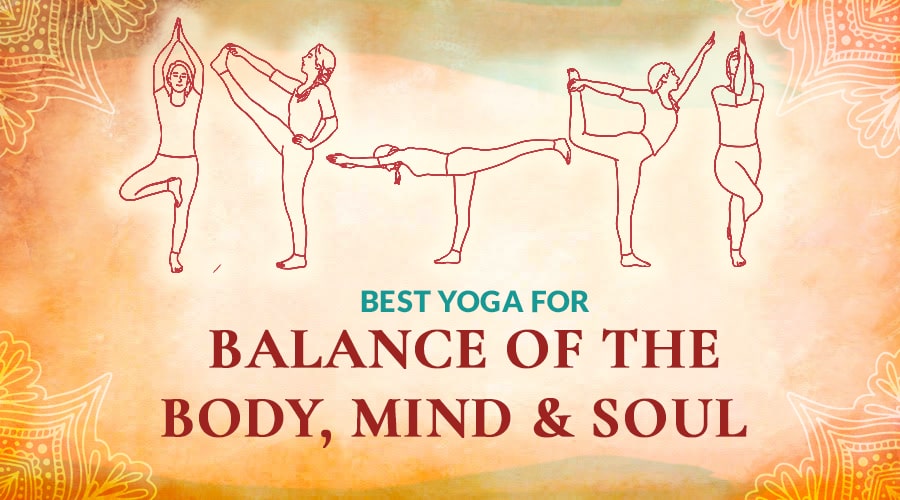Imagine standing in Tree Pose with one leg lifted and your eyes closed. The world shifts around you, but you remain still, grounded, and in tune with yourself and the universe. This is the essence of yoga; a flame that once lit, can guide you through the ups and downs of life. Whether you're struggling to find steadiness in a standing yoga pose or are grappling with work stress, yoga is a powerful tool that can improve balance on the yoga mat and beyond.
In this yoga for balance guide, we'll introduce you to five transformative practices for total stability and well-being. You'll flow through essential yoga balance poses and discover holistic yoga techniques such as breathwork and chakra meditation, all designed to help you focus and find your center again.
How Does Yoga Improve Balance?
Yoga brings a wealth of benefits to our bodies and minds. From soothing neck pain to boosting gut health, it offers an all-natural path to holistic healing and well-being. But a benefit of yoga that often goes unnoticed is balance.
Balance is essential in our daily lives, helping us perform simple tasks like walking the dog or even sitting at a desk. Yet as we age, this innate skill begins to wane. Through standing yoga poses and exercises, we can sharpen our body's response to gravity and strengthen vital muscles that support us through everyday movements. Yoga for balance also offers a deep sense of stability and harmony within. Let’s take a closer look at the different ways yoga improves balance.
Builds Muscles Strength
In Hatha Yoga, we practice static and dynamic standing poses that engage and strengthen important muscle groups needed to maintain balance, especially the lower body. For example, in yoga balance poses like Tree Pose (Vrikshasana) or the 5 Warrior Poses, the leg muscles, core, and even the small stabilizing muscles in the feet and ankles are activated and strengthened. By working and building these muscles regularly, we’re able to maintain hip alignment, improve body posture, and boost stability in daily activities.
Enhances Body Awareness
Yoga balance poses and breathwork heightens our sense of proprioception; the body's ability to sense its location, movements, and actions without looking. In yoga, you’re encouraged to connect your body with your breath. As you flow from one asana to the next, you become more aware of the placement of each limb, the tilt of your pelvis, and the alignment of your spine. This heightened awareness helps improve balance as you become more attuned to your body's position in space.
Speeds up Reaction Time
While strengthening the vital muscles supporting our skeletal system, studies on yoga for balance also show that it can successfully improve visual and auditory reaction times. For instance, challenging balancing poses, such as the Half Moon Pose (Ardha Chandrasana), require a higher level of concentration. By enhancing our focus, we’re able to react quicker to unpredictable moments. This skill can reduce injury and improve our physical performance in all kinds of activities, whether it's running, climbing, or practicing yoga.
Improves Coordination
Complex balance poses and flow sequences in yoga, like those found in Vinyasa or Ashtanga styles, see the body move gracefully from one pose to another. While challenging in the beginning, this fluid movement trains the body to coordinate different muscle groups efficiently. The result is improved neuro-muscular coordination and better body awareness, focus, and control.
Encourages Emotional & Energetic Stability
Beyond the physical benefits, yoga also promotes mental and emotional and energetic equilibrium. Meditation in yoga promotes mindfulness and introspection, helping us transcend the distractive states of mind and reach ultimate peace and calmness. Along with calming breathing exercises and yoga poses, this technique can help reduce stress, anxiety, and even depression.
Try this 15-Minute Yoga Practice for Stress Relief
Chakra healing is another powerful tool used in yoga for balance. Through techniques like chakra yoga poses, meditation, affirmations, and mudras, we manipulate the flow of prana (life force energy), bringing balance to the 7 energy centers. When these chakras are in harmony, we feel more energetically balanced, centered, and calm.
Neutralizes the Nervous System
Studies in yoga physiology have shed light on the impact of yoga and breathing exercises on the brain, helping stimulate the part of the nervous system responsible for rest and relaxation. One example is Alternate Nostril Breathing (Nadi Shodhana); a breathing exercise designed to balance the left and right hemispheres of the brain.
Regular practice, combined with specific yoga poses, can create a sense of inner calm that benefits the entire body, from our mood and mental state to our digestive system and heart health. It also strengthens and purifies the nadis, or subtle energy channels (Ida, Pingala, and Sushumna), in the astral body.
Read: Pranayama Benefits & Daily Breathing Techniques for a Longer Life
Best Practices in Yoga for Balance, Strength & Holistic Health
Yoga Balance Poses
The below yoga balancing poses challenge your neuro-muscular system and strengthen key muscle groups responsible for your coordination and sense of stability. As you flow through these standing poses, don't forget about the power of breath and focused gaze (Drishti). By breathing and centering your focus, you not only improve your balance but also anchor yourself deeper into your practice.
Tree Pose (Vrikshasana)
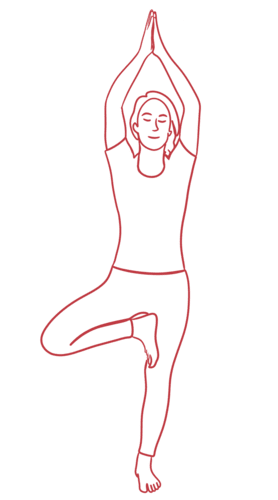
- Stand straight, with your feet together.
- Raise your hands above your head and place your palms together, in line with your forehead.
- Breathe in, slowly raise your right foot and place it against your left inner thigh.
- Keep your focus on a point slightly above eye level (approximately 2 meters away), and take deep, natural breaths.
Dancer Pose (Natarajasana)
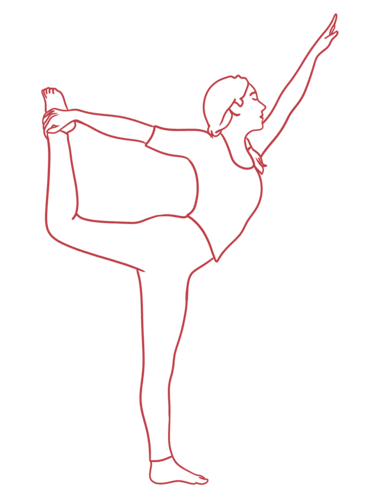
- Begin this one leg standing pose in the center of your mat, spine long and feet together.
- Shift your weight onto your right foot, while reaching your left heel towards your left buttock.
- Grasp the inside of your left ankle with your left hand, extending your right arm upwards.
- Push your left foot into your left hand, tilting forward slightly, with your chest lifted and right arm forward.
- Fix your gaze on a point and maintain steady breathing.
Eagle Pose (Garudasana)
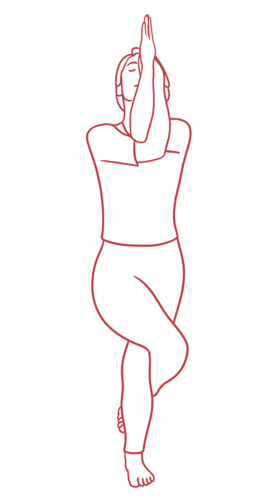
- Stand upright with your feet together in the relaxed standing pose, Mountain Pose.
- Bend your knees slightly, then lift your right leg, crossing it over your left thigh.
- If you can, wrap your right foot around your left calf.
- Extend your arms in front of you and cross your right arm over your left, bending at the elbows.
- Join your palms together, so they're almost touching or intertwining your wrists.
- Sit down into the pose slightly, keeping a focused gaze, and breathe consistently.
Extended-Hand-to Big-Toe Pose (Utthita Hasta Padangusthasana)
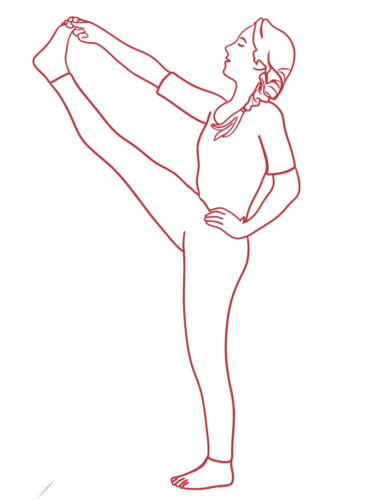
- Start by standing tall with feet together in Tadasana.
- With your gaze focused, shift your weight onto your left foot and lift your right knee towards your chest.
- Grab your right big toe with your right fingers, using your thumb to support it.
- Extend your right leg forward, straightening it as much as you can. Remember to breathe, keep your spine long, and chest open.
- If comfortable, you can also extend your right leg out to the side.
- Keep your left arm on your hip or extend it out for balance.
- Fix your gaze on a point about 2 meters away and keep your breath steady.
Balancing Stick (Tuladandasana)
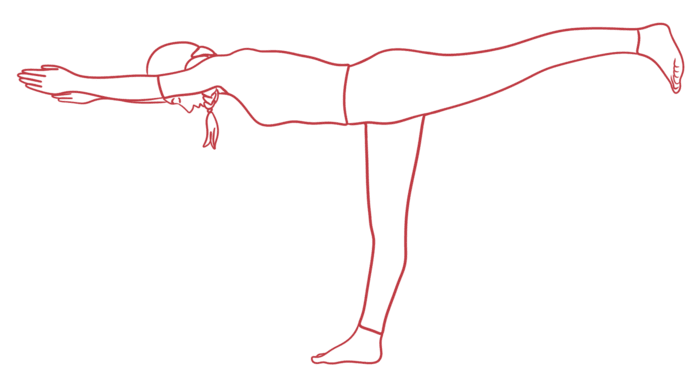
- Start this yoga balance pose standing tall with feet together.
- Extend your arms straight above your head, interlocking your fingers with your index fingers pointing upwards.
- Shift your weight onto your left leg.
- At the same time, hinge at your hips to tilt your torso forward, while raising your right leg straight behind you.
- Your body should form a straight line from your extended fingertips to your raised heel.
- Steady yourself, breathing evenly, and maintaining your focus.
Breathwork
From Alternate Nostril Breathing to Bumble Bee Breath, the above breathwork challenge provides 4 essential breathing exercises in yoga for balance, stillness, and stability. You’ll experience a powerful sense of calmness during this practice, but with each breath, you’ll also filter out toxins, increase oxygenation, and improve vital functions of the body. This supports your overall nervous system and keeps it in balance.
Discover: 3 Yogic Breathing Exercises to Calm Down
Ayurveda & the Doshas
Ayurveda revolves around the concept of the three doshas—Vata, Pitta, and Kapha—vital energy forces that shape our body and mind. Each dosha is made up of elements that carry unique characteristics and functionalities. By recognizing which elements tend to accumulate within you more, you can identify your dominant dosha and work towards achieving a balanced state of health. If you don’t know your dosha type, try our quick assessment below.
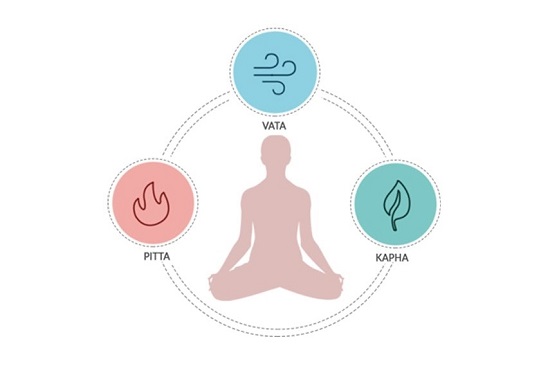
Discover your Ayurvedic constitution (dosha-dominance) with our free self-assessment.
Fill out our specially curated assessment to discover your dosha balance.
There are various methods in yoga to balance your doshas. A common approach is the Shat Kriyas, or six yogic cleansing techniques. Following a holistic diet designed for your dosha type is also essential. Lastly, living a balanced lifestyle with consistent exercise, yoga, and meditation further enhances this equilibrium.
Chakra Balancing
Meditation & Affirmations
Balancing our chakras is essential for holistic well-being, as these energy centers are intricately connected to the organs and glands around them. When a chakra becomes imbalanced, it can disrupt our entire system, potentially leading to physical discomfort or mental challenges like anxiety and depression.
Yogic techniques like chakra meditation, affirmations, and mudras target these energy centers with focused energy that realigns them. This brings harmony to our physical body as well as our emotional and mental well-being. Follow the guided chakra meditation practice above to balance and heal the full chakra energy system from the root to the crown.
To boost your chakra balancing, you can also try these chakra yoga poses.
Final Thought
Embracing yoga for balance isn't just about nailing the perfect standing pose. By learning how to find stillness and harmony within, you equip yourself with tools to remain strong and steadfast against life’s challenges, whether that's a one legged standing asana or chronic work stress. In the wise words of B.K.S. Iyengar,
“Balance in the body is the foundation for balance in life.”

